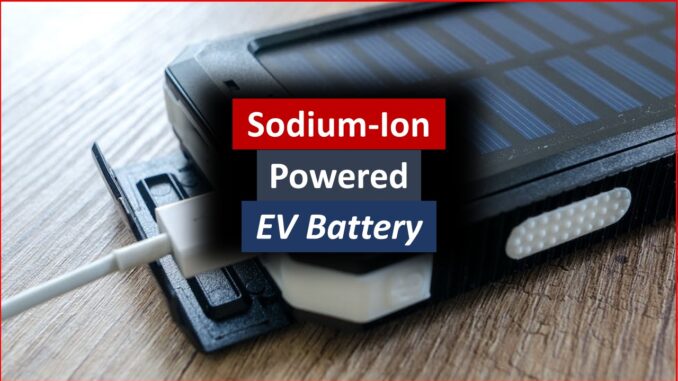
The first mass-produced electric vehicle (EV) using a sodium-ion battery has been introduced by JAC Motors. The EV will be branded under Yiwei which is their new brand under JAC Motors.
What’s The Buzz Here? Why Do We Care?
While lithium-ion batteries are more developed and have a higher density than sodium-ion batteries, sodium-ion batteries are cheaper, dependable, and have better cold-weather performance. All these qualities may hasten the widespread adoption of EVs. Sources from China say that the deliveries will begin this month
The Yiwei brand was created on April 12 2023 under JAC. Volkswagen Anhui holds 50% of Jianghuai Automobile Group Holdings(JAG), the parent company of JAC, and has 75% ownership and managerial control over JAC. It is one of the oddest combinations in the car manufacturing industry as the other half of JAG is owned by the Chinese government.
What To Expect From the EV
The Yiwei EV seems to be a rebadged Sehol E10X hatchback, which was unveiled earlier last year. According to CarNewsChina, the Sehol model had a 252 km (157 mi) range, a HiNa NaCR32140 cell with 25 kWh capacity and an energy density of 120 Wh/kg. The car supports 3C to 4C charging.
Last May, JAC announced that it would discontinue the Sehol brand name and rebrand all of its cars as JAC or Yiwei. JAC has not yet stated if the car sold under the Yiwei brand would continue to use the E10X name which it had under the Sahol brand.
At the Shanghai Auto Show in April 2023, JAC unveiled the Yiwei 3, a different electric vehicle with an LFP lithium battery and rolled out to the roads in June, with the promise that the sodium-ion version would follow later.
HiNA Battery’s cylindrical sodium-ion cells are expected in the upcoming Yiwei EV. Like CATL’s CTP (cell-to-pack) and BYD’s Blade, JAC assembles the batteries in the company’s modular UE (Unitized Encapsulation) honeycomb framework promising higher performance and stability.
Why Sodium-ion Batteries?
In sodium-ion batteries, just like in the Lithium-ion battery, an anode, cathode, separator, and electrolyte are used in the same chemical processes that lithium-ion batteries use to power their devices. The main distinction is that sodium ions and salts are used instead of lithium.
The main advantage of using Sodium here is the cost-effectiveness. This is because Sodium-ion batteries don’t require expensive components like cobalt, copper, lithium, or graphite in contrast to lithium-ion batteries.
The fact that sodium-ion batteries use inexpensive, readily available raw materials is one of their main benefits. Analysts argue that even with the average reduction in the cost of Li-ion batteries in the last decade, EVs cannot become economically competitive with fossil fuel cars until the cost of batteries drops much more, to $151/kWh.
What Else is Brought To The Table?
The safety of sodium-ion batteries is another noteworthy benefit and the sodium-ion batteries can function at nearly full capacity in extreme cold conditions, down to below -30 degrees Celsius (-22 degrees Fahrenheit).
Sodium-Ion batteries can be extensively used in smaller, low-range electric vehicles and stationary applications like home energy storage systems. Sodium-ion batteries work better in EVs that don’t need a large driving range, such as city cars small cars and last-mile delivery vehicles because of their lower energy density.
To further explore the potential, companies like Silicon Valley’s Natron Energy and the UK’s Faradion are aggressively working to bring sodium-ion battery technology to the mass market. Prominent companies like Chevron and United Airlines are already using these batteries for their EV charging systems.
Another Sodium-ion Powered EV From China
Chinese car manufacturer JMEV rolled off their sodium-Ion battery-provided EV on December 28, 2023. China-based battery manufacturer Farasis Energy is supplying sodium-ion batteries for the EV. JMEV is an electric vehicle brand owned by Jiangling Motors Group based in China
The JMEV EV3’s small size and 251 km of driving range can meet daily commuting and cross-city travel needs. Farasis claims the energy density of the mass-produced sodium-ion batteries ranges from 140 to 160 Wh/kg. The battery technology is compatible with both electric two-wheelers and passenger EVs with a discharge capacity retention of over 91%.
According to Farasis, the company plans to introduce its second generation of sodium-ion batteries in 2024, increasing their energy density to a range of 160–180 Wh/kg. Further, the density will be increased to between 180 and 200 watts per kilogramme in 2026 to meet new demands.
Farasis has a handful of joint sodium battery projects with other companies concentrated on energy storage systems, two-wheelers, battery swapping, and EVs.
Numerous manufacturers in China are pursuing sodium-ion research; BYD recently declared plans to establish a 30 GWh sodium battery factory in Xuzhou through a joint venture with the massive tricycle company Huaihai Group. Ten billion yuan (1.4 billion USD) are invested in all.
Conclusion
In the future, sodium-ion batteries are anticipated to be a crucial component of the battery mix. Two-wheelers, entry-level EVs, and stationary energy storage have the greatest use for them. They work better in cold conditions, are less expensive than LFP, and don’t require lithium but they have a lower energy density.
So as we have discovered, Sodium-ion batteries may not be a great fit for long-range EVs but they are great for short-range EVs and other applications. From an environmental perspective, we need to increase green mobility in cities rather than rural areas since they are heavily polluted by CO2 emissions. Sodium-Ion batteries are a cheap but effective way of dealing with this problem by employing them in last-mile operations and short-distance transportation.